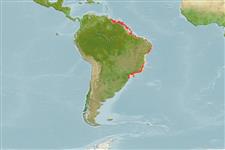Environment: milieu / climate zone / depth range / distribution range
Ecologia
marinhas; Água doce; estuarina; anádromo (Ref. 26213); intervalo de profundidade 1 - 50 m (Ref. 189). Tropical; 9°N - 27°S, 61°W - 33°W (Ref. 189)
Western Atlantic: Orinoco delta in Venezuela south to Ponta da Cotinga, Paraná coast of Brazil.
Comprimento de primeira maturação / Tamanho / Peso / Idade
Maturity: Lm 9.4, range 7 - ? cm
Max length : 18.0 cm TL macho/indeterminado; (Ref. 102462); common length : 9.0 cm TL macho/indeterminado; (Ref. 5217); peso máx. publicado: 32.00 g (Ref. 118626)
Espinhos dorsais (total) : 0; Raios dorsais (total) : 14 - 17; Espinhos anais: 0; Raios anais : 19 - 26. Body moderately elongate and compressed (Ref. 189). Snout short, about 2/3 eye diameter; maxilla relatively long, tip bluntly rounded, reaching to pre-operculum; gill cover canals of walkeri-type (Ref. 189). Anal fin fairly long, its origin below about middle of dorsal fin base. A broad silver stripe along flank, equal or greater than eye diameter below dorsal fin (Ref. 189).
A schooling species found inshore. Most likely anadromous, entering estuaries and freshwater. Feeds on crustacean larvae or small invertebrates (Ref. 12225). Female maximum length from Ref. 71685.
Both sexes at maturity have a large amount of visceral and intermuscular fat (Ref. 189). Spawn in school (Ref. 205).
Whitehead, P.J.P., G.J. Nelson and T. Wongratana, 1988. FAO Species Catalogue. Vol. 7. Clupeoid fishes of the world (Suborder Clupeoidei). An annotated and illustrated catalogue of the herrings, sardines, pilchards, sprats, shads, anchovies and wolf-herrings. FAO Fish. Synop. 125(7/2):305-579. Rome: FAO. (Ref. 189)
Status na Lista Vermelha da UICN (Ref. 130435)
Ameaça para os humanos
Harmless
Uso pelos humanos
Pescarias: pouco comercial
Ferramentas
Relatórios especiais
Baixar XML
Fontes da internet
Estimates based on models
Preferred temperature (Ref.
123201): 24.5 - 27.8, mean 27.2 °C (based on 68 cells).
Índice de diversidade filogenética (Ref.
82804): PD
50 = 0.5000 [Uniqueness, from 0.5 = low to 2.0 = high].
Bayesian length-weight: a=0.00537 (0.00466 - 0.00618), b=3.13 (3.09 - 3.17), in cm total length, based on LWR estimates for this species (Ref.
93245).
Nível Trófico (Ref.
69278): 3.1 ±0.30 se; based on food items.
Resiliência (Ref.
120179): Elevada, tempo mínimo de duplicação da população menor que 15 meses (Fec=20,202).
Fishing Vulnerability (Ref.
59153): Low vulnerability (10 of 100).
Nutrients (Ref.
124155): Calcium = 273 [153, 637] mg/100g; Iron = 1.9 [1.1, 3.4] mg/100g; Protein = 18.3 [16.9, 19.7] %; Omega3 = 0.306 [0.154, 0.612] g/100g; Selenium = 41.1 [18.3, 94.0] μg/100g; VitaminA = 27.4 [8.1, 73.8] μg/100g; Zinc = 2.03 [1.39, 3.01] mg/100g (wet weight);
